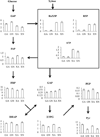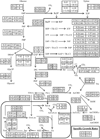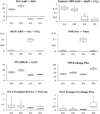Metabolomic and (13)C-metabolic flux analysis of a xylose-consuming Saccharomyces cerevisiae strain expressing xylose isomerase
- PMID: 25311863
- PMCID: PMC4801006
- DOI: 10.1002/bit.25447
Metabolomic and (13)C-metabolic flux analysis of a xylose-consuming Saccharomyces cerevisiae strain expressing xylose isomerase
Abstract
Over the past two decades, significant progress has been made in the engineering of xylose-consuming Saccharomyces cerevisiae strains for production of lignocellulosic biofuels. However, the ethanol productivities achieved on xylose are still significantly lower than those observed on glucose for reasons that are not well understood. We have undertaken an analysis of central carbon metabolite pool sizes and metabolic fluxes on glucose and on xylose under aerobic and anaerobic conditions in a strain capable of rapid xylose assimilation via xylose isomerase in order to investigate factors that may limit the rate of xylose fermentation. We find that during xylose utilization the flux through the non-oxidative Pentose Phosphate Pathway (PPP) is high but the flux through the oxidative PPP is low, highlighting an advantage of the strain employed in this study. Furthermore, xylose fails to elicit the full carbon catabolite repression response that is characteristic of glucose fermentation in S. cerevisiae. We present indirect evidence that the incomplete activation of the fermentation program on xylose results in a bottleneck in lower glycolysis, leading to inefficient re-oxidation of NADH produced in glycolysis.
Keywords: 13C-metabolic flux analysis; Saccharomyces cerevisiae; carbon catabolite repression; cellulosic ethanol; metabolomics; xylose.
© 2014 Wiley Periodicals, Inc.
Conflict of interest statement
The authors declare that they have no conflict of interest.
Figures






Similar articles
-
Production of fuels and chemicals from xylose by engineered Saccharomyces cerevisiae: a review and perspective.Microb Cell Fact. 2017 May 11;16(1):82. doi: 10.1186/s12934-017-0694-9. Microb Cell Fact. 2017. PMID: 28494761 Free PMC article. Review.
-
Xylose isomerase overexpression along with engineering of the pentose phosphate pathway and evolutionary engineering enable rapid xylose utilization and ethanol production by Saccharomyces cerevisiae.Metab Eng. 2012 Nov;14(6):611-22. doi: 10.1016/j.ymben.2012.07.011. Epub 2012 Aug 16. Metab Eng. 2012. PMID: 22921355
-
Engineering of Saccharomyces cerevisiae for the efficient co-utilization of glucose and xylose.FEMS Yeast Res. 2017 Jun 1;17(4). doi: 10.1093/femsyr/fox034. FEMS Yeast Res. 2017. PMID: 28582494 Review.
-
Ethanol production from lignocellulosic hydrolysates using engineered Saccharomyces cerevisiae harboring xylose isomerase-based pathway.Bioresour Technol. 2016 Jun;209:290-6. doi: 10.1016/j.biortech.2016.02.124. Epub 2016 Mar 9. Bioresour Technol. 2016. PMID: 26990396
-
Quantitative metabolomics of a xylose-utilizing Saccharomyces cerevisiae strain expressing the Bacteroides thetaiotaomicron xylose isomerase on glucose and xylose.J Ind Microbiol Biotechnol. 2017 Oct;44(10):1459-1470. doi: 10.1007/s10295-017-1969-1. Epub 2017 Jul 25. J Ind Microbiol Biotechnol. 2017. PMID: 28744577
Cited by
-
Multi-Omics Analysis of Fatty Alcohol Production in Engineered Yeasts Saccharomyces cerevisiae and Yarrowia lipolytica.Front Genet. 2019 Aug 30;10:747. doi: 10.3389/fgene.2019.00747. eCollection 2019. Front Genet. 2019. PMID: 31543895 Free PMC article.
-
Investigation of useful carbon tracers for 13C-metabolic flux analysis of Escherichia coli by considering five experimentally determined flux distributions.Metab Eng Commun. 2016 Jun 7;3:187-195. doi: 10.1016/j.meteno.2016.06.001. eCollection 2016 Dec. Metab Eng Commun. 2016. PMID: 29142823 Free PMC article.
-
Complete genome sequence, metabolic model construction and phenotypic characterization of Geobacillus LC300, an extremely thermophilic, fast growing, xylose-utilizing bacterium.Metab Eng. 2015 Nov;32:74-81. doi: 10.1016/j.ymben.2015.09.009. Epub 2015 Sep 21. Metab Eng. 2015. PMID: 26391740 Free PMC article.
-
Construction of a xylose metabolic pathway in Trichosporonoides oedocephalis ATCC 16958 for the production of erythritol and xylitol.Biotechnol Lett. 2023 Dec;45(11-12):1529-1539. doi: 10.1007/s10529-023-03428-1. Epub 2023 Oct 13. Biotechnol Lett. 2023. PMID: 37831286
-
A comprehensive evaluation of constraining amino acid biosynthesis in compartmented models for metabolic flux analysis.Metab Eng Commun. 2017 Jul 11;5:34-44. doi: 10.1016/j.meteno.2017.07.001. eCollection 2017 Dec. Metab Eng Commun. 2017. PMID: 29188182 Free PMC article.
References
-
- Almeida JR, Modig T, Petersson A, Hähn-Hägerdal B, Lidén G, Gorwa-Grauslund MF. Increased tolerance and conversion of inhibitors in lignocellulosic hydrolysates bySaccharomyces cerevisiae. J Chem Technol Biotechnol. 2007;82:340–349.
-
- Amore R, Wilhelm M, Hollenberg CP. The fermentation of xylose--an analysis of the expression of Bacillus and Actinoplanes xylose isomerase genes in yeast. Appl Microbiol Biotechnol. 1989;30:351–357.
-
- Andreasen AA, Stier TJ. Anaerobic nutrition of Saccharomyces cerevisiae. II. Unsaturated fatty acid requirement for growth in a defined medium. J Cell Physiol. 1954;43:271–281. - PubMed
-
- Andreasen AA, Stier TJB. Anaerobic nutrition of Saccharomyces cerevisiae. I. Ergosterol requirement for growth in a defined medium. J Cell Physiol. 1953;41:23–36. - PubMed
-
- Antoniewicz MR, Kelleher JK, Stephanopoulos G. Determination of confidence intervals of metabolic fluxes estimated from stable isotope measurements. Metab Eng. 2006;8:324–337. - PubMed
Publication types
MeSH terms
Substances
Grants and funding
LinkOut - more resources
Full Text Sources
Other Literature Sources
Miscellaneous

